Supercomputing 2018: EPYC, Immersion and Quantum Computing
HGX-2 Expansion
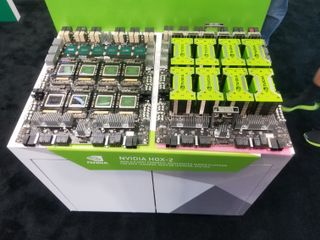
Nvidia had its DGX-2 station, which company CEO Jensen Huang famously billed as the "World's largest GPU," at the show, but we also found a plethora of new HGX-2 designs on the show floor. The HGX-2 is a reference hyperscale design that allows OEMs/ODMs to build standardized supercomputers. Just like the DGX-2, which is sold directly from Nvidia, the HGX-2 comes with 16 Tesla V100 GPUs and half a terabyte of total GPU memory tied together with 12 NVSwitches. That powers up to 12 petaflops of performance in one chassis.
The large number of HGX-2 platforms is encouraging for Nvidia as it seeks to strengthen its leading position in deep learning in the data center.
Xilinx Brings PCIe 4.0 To FPGAs
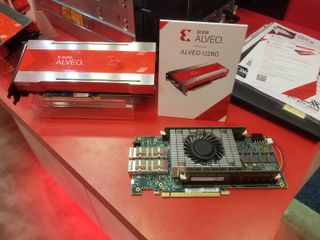
Xilinx unveiled its new Alveo U280 FPGA at the show. All workloads are either bound by storage I/O, memory, or compute restrictions, and the new U280 grapples with several of those eventualities. The card brings several firsts to the FPGA space: the PCIe 4.0 interface, 8GB of on-package HBM2, and support for CCIX. The improved PCIe interface allows for faster throughput into and out of the card, helping address I/O constraints, while fast HMB2 memory provides up to 460GB/s of throughput, which helps with memory constraints.
The CCIX interconnect also weighs into providing a low-latency, high-bandwidth, cache-coherent interface for shared memory access with other CCIX-compliant devices, providing a nice path forward as the CCIX ecosystem expands.
Samsung's NF1 SSDs
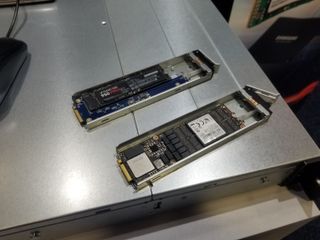
We found Samsung's new NF1 SSDs in several servers at the show, which does imply that the company's proprietary form factor is gaining at least some traction in the industry. However, we also spotted a few designs that leveraged the Intel-backed EDSFF form factor (commonly known as the Ruler) that has evolved into an industry standard.
Data center customers and OEMs alike prefer to build devices based on industry-accepted standards, which doesn't bode well for Samsung's proprietary NF1 form factor in the future. In fact, the PCI-SIG standards committee recently threw the flag on incompatibility between NF1 and M.2 SSDs, which may be just the first sign that the lack of standards adoption will haunt the promising form factor.
The Mad Dash To Use Flash As Memory Cache

Western Digital has taken its existing SN200 enterprise SSDs, slathered on a bit of software magic, and created its new DC ME200 Memory Extension Drive. This NVMe drive combines with software to enable users to leverage traditional flash storage as a memory extension, thus increasing the addressable memory space in a server. The drive comes in U.2 and standard Add-In Card form factors to provide broad compatibility with existing infrastructure. The drives come in 1TB, 2TB and 4TB models that boost the addressable memory pool by leaps and bounds.
Stay on the Cutting Edge
Join the experts who read Tom's Hardware for the inside track on enthusiast PC tech news — and have for over 25 years. We'll send breaking news and in-depth reviews of CPUs, GPUs, AI, maker hardware and more straight to your inbox.
Once installed, WD claims the drive offers near-memory performance in a wide range of typical server applications. Users also get the added assurance of data persistence for the data stored on the drive, and though endurance is always a concern with flash-based devices, WD feels the 17 Drive Writes Per Day endurance rating should be sufficient for all but the most extreme use-cases. WD claims this innovative approach will boost memory capacity and reduce licensing fees, but for a small premium over normal SSD pricing.
Fujitsu's AF64FX Chip

Japan's Post-K supercomputer doesn't make its debut until 2021, but Fujitsu is already hard at work on the new ARM-based A64FX chip that will serve as the centerpiece. The chip is manufactured on the 7nm process and features 8.7 billion transistors. The 48-core processor, which also has four 'assistant' cores, is designed to excel at AI workloads and is projected to deliver up to 2.7 teraflops for FP64 operations, 5.4 teraflops for FP32, and 10.8 teraflops for FP16. Max performance weighs in at 21.6 teraflops for 8-bit integer operations.
Fujitsu claims the chip is incredibly power efficient but hasn't provided specific measurements. The chip also has 32GiB of on-package HBM2, while the chip also supports up to 1,024 GB/s of throughput from main memory.
Off To The Races With Z-NAND
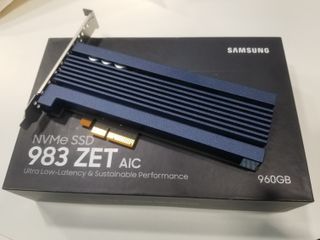
Samsung had its Z-NAND powered 983 ZET at the show. Samsung designed Z-NAND to be a cheaper alternative to Intel’s Optane. Instead of starting from a blank drawing board, the company simply modified existing SLC flash by shrinking the wordlines and bitlines. The HHHL (half-height half-length) Add-In Card comes in 480GB and 960GB capacities and wields 1.5GB of LPDDR4 DRAM.
Top line performance numbers include 3,400/3,000 GB/s of sequential read/write throughput, but Samsung hasn't released the most important specification: random performance. We do know the 960GB model can absorb up to 17,520 TB of write data and comes with a five-year warranty.
Samsung Makes SSDs Smart
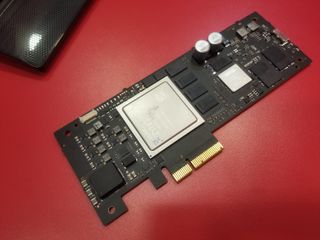
Samsung's SmartSSD features a field programmable gate array (FPGA) chip onboard an SSD so that data can be processed onboard the drive without eating up CPU cycles or requiring data movement. The drive features a high-bandwidth internal data path between the SSD and FPGA to speed data processing. Samsung designed the FPGA with Xilinx, but the company uses the existing SDAccel Environment FPGA programming language.
Samsung currently only offers an Add-In Card SSD, but plans to add a U.2 model in the future. Samsung envisions the drive being used in database, video, AI and ML, storage & virtualization workloads.

Paul Alcorn is the Managing Editor: News and Emerging Tech for Tom's Hardware US. He also writes news and reviews on CPUs, storage, and enterprise hardware.
Most Popular


